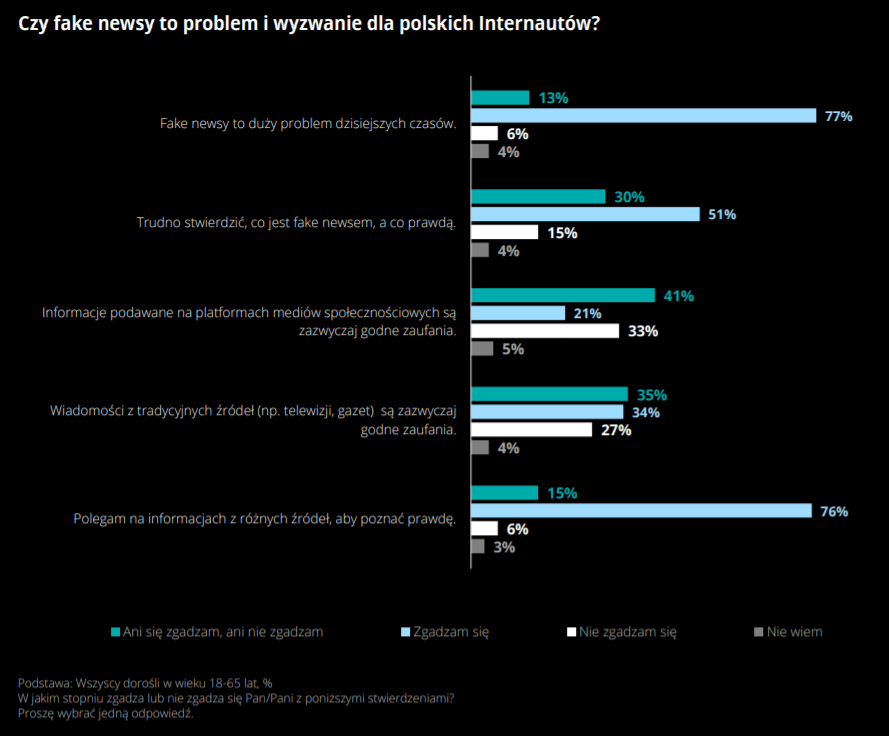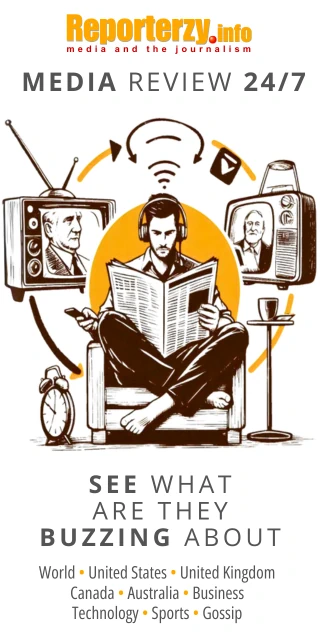Top methods Poles use to follow news and current events:
- 28% - television
- 28% - social media
- 18% - news websites or apps
- 8% - radio
- 10% - other
- 8% - not interested in following news
Given that over a quarter of consumers rely on sources with challenging credibility verification, fake news remains a serious problem. While 77% of respondents acknowledge the issue, 51% admit difficulty in assessing the truthfulness of information.
The high popularity of social media as an information source is concerning, as experts warn it provides an ideal environment for the rapid spread of unverified information. Moreover, fewer social media users find these platforms trustworthy compared to television (21% vs. 34%).
 Source: Digital Consumer Trends 2021, Deloitte
Source: Digital Consumer Trends 2021, DeloitteThree-quarters of respondents claim to verify the origin of the information they receive.
- The highly effective spread of unfounded theories suggests that verification often happens within other social media channels sharing the same content, says Rafał Wojciechowski, senior manager at Deloitte. - One of the biggest challenges for media and regulators should be ensuring effective mechanisms to confirm the accuracy of information.
Social Media Less Popular
The overload of false information prompts only slightly more than one-fifth of Deloitte`s respondents to stop using social media. The most common reason, cited by a third of respondents, is boredom with the platform, especially among older users (39% in the 55-65 age group). One in four mentions spending too much time on social media as a reason to quit.
Interestingly, the youngest users are the most likely to temporarily or permanently quit at least one social media platform - 43% of 18-24-year-olds, compared to just one in five in the 55-65 age group.
- The desire to spend time more meaningfully, distance oneself from polarizing discussions, and improve well-being also drives users away from social media, says Maciej Dakowicz, senior manager at Deloitte Digital. - This trend requires marketers to diversify communication channels to reach different target groups and create valuable content that positively impacts users.
Find the second part of the Digital Consumer Trends 2021 report at:
https://www2.deloitte.com/pl/pl/pages/technology-media-and-telecommunications/articles/Digital-Consumer-Trends-2021-part-2.html
Identifying Fake News
Artificial intelligence is increasingly used to create fake information. Software now exists to manipulate public speeches by politicians. For instance, a video of Barack Obama delivering the same speech at different ages was generated using specialized software. This technology means public appearances by any politician can now be fabricated.
A large-scale example of fake news manipulation was the 2018 Facebook scandal. Cambridge Analytica acquired data from over 50 million Facebook users to create personalized ads influencing voter decisions. This likely impacted the Brexit vote and the U.S. presidential election.
Fake News in Poland and Europe
Three-quarters of Poles encounter fake news or distorted information at least once a week. Only 14% believe this issue does not affect them, according to Kantar Public`s Eurobarometer survey.
When asked, "Does the presence of distorted or false information pose a problem in your country?" 84% of Poles responded affirmatively:
- 49% - definitely yes
- 35% - somewhat yes
- 9% - somewhat no
- 3% - definitely no
- 4% - don`t know/no opinion
These results place Poland in line with the EU average (44% - definitely yes, 41% - somewhat yes).
Eurobarometer findings echo a Press Club Polska analysis on trust in media information, showing the highest trust in social news and the lowest in political news:
- social news: trust 68%, distrust 30%
- economic news: trust 57%, distrust 40%
- political news: trust 46%, distrust 49%
According to Press Club Polska, credibility in media is most influenced by presenting independent expert opinions, referencing scientific research, and citing diverse sources, rather than the neutrality of language or source popularity.
COMMERCIAL BREAK
New articles in section Media industry
Journalism in the age of AI. Why people prefer humans over machines
Krzysztof Fiedorek
Only 12% of people accept news created solely by AI, while 62% prefer those written by humans. At the same time, only 19% notice labels indicating the use of artificial intelligence, while younger audiences ask AI to explain the content to them. These are the findings of the Reuters Institute report on artificial intelligence in media.
Why do we believe fakes? Science reveals the psychology of virals
KFi
Why do emotions grab more attention than evidence, and why can a fake authority overshadow scientific data? Researchers from Warsaw University of Technology, Jagiellonian University, and SWPS University in Poland sought the answers. Here are their findings.
Investigative journalism in Europe. Newsrooms face pressure
KFi, Newseria
Media and political representatives point to the difficult situation of investigative journalism in Europe. Newsrooms are reluctant to invest in this segment due to high costs and the large amount of time and effort required. Most of all, however, they fear legal proceedings.
See articles on a similar topic:
How to silence fake news? Young Latinos support internet censorship
Krzysztof Fiedorek
In Brazil, a court shut down platform X, cutting off 40 million users. In Colombia, 70% of citizens want information control, and in Chile, 75% of young people support censoring fake news. Is information security replacing freedom of speech as a new trend? [STUDY]
Mass Media in Poland
Agnieszka Osińska
Into the decade of years 90. Poland entered with media national, subjected to the political control. Starting from the half of 1989 our media market underwent transformations, biggest probably from the time of the World War II.
Radio, Streaming, and Podcasts. Total Audio 2024 Report about Poland
Krzysztof Fiedorek
Audio content is a daily companion for Poles. According to the Total Audio 2024 study conducted by Adres:Media on behalf of the Radio Research Committee, as many as 90% of respondents listen to audio content at least once a week, and 80% do so daily. The average listening time is nearly five hours per day.
Models of Journalistic Organizations
Zenon Kuczera
An overview, operational principles, and characteristics of journalistic organizations operating in Belgium, Canada, Switzerland, and the United States.






























